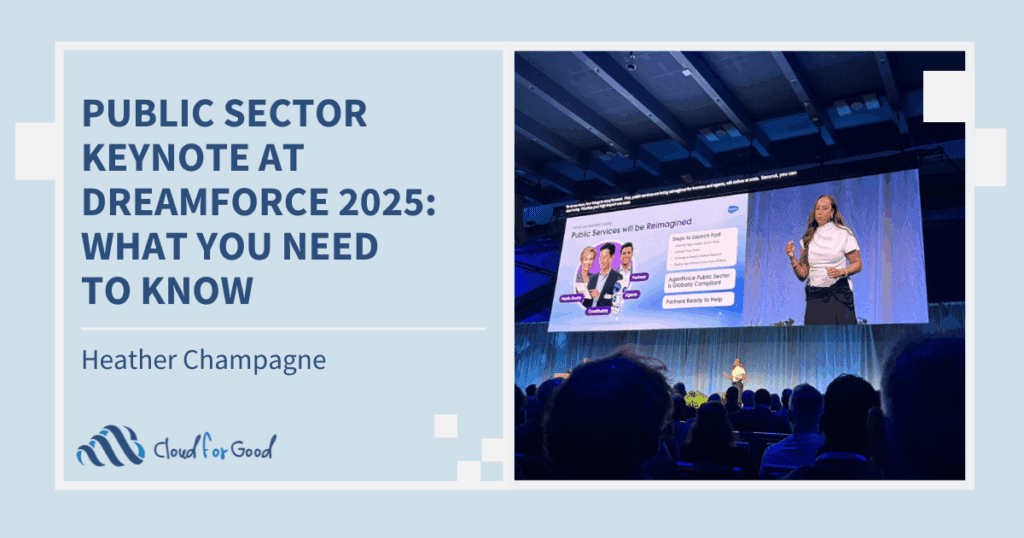Relationships as a general idea are fundamental to Salesforce. After all, Salesforce is a CRM – or constituent relationship management – tool. And you may often hear about it talked about as a relational database. But most nonprofits have some particular needs around tracking relationships between the people and organizations they work with. Your universe of constituents is probably complicated and interconnected, with people you know serving different roles at organizations that matter to you. And, they likely know other individuals that you’re engaging, or that you want to engage.
Many nonprofits’ needs in this area are not be met by Salesforce out of the box, so once again it’s the Nonprofit Success Pack (NPSP) to the rescue! In this post we’ll see how you can best track individual and organizational relationships with Salesforce and NPSP.
Tracking Organizational Relationships with Affiliations
Let’s take a look first at person to organization relationships. In a typical ‘business to business’ (B2B) model, a Salesforce user may only care about people as employees of a particular company to which they’re selling. But in the nonprofit world, our relationships to individuals can be much more complex. Almost anyone could be a donor or potential donor, but we may also want to see where they work and interface with them in that context. They could also be a member of your board of directors, or of a major foundation’s board. How do we track all of this in Salesforce?
The Household Account Model of managing Contacts and Accounts, the recommended model for nonprofits using Salesforce, allows you to track these multi-lateral organizational relationships while still leveraging Salesforce’s core data structure and reporting capabilities. With it, each contact is created under a ‘household’ account, but can also be related to other organization accounts via Affiliations.
An affiliation record sits between a person (contact) record and any organization (account), linking them together and providing detailed information of the person’s role at the organization. You can create affiliations to designate where someone works, whose board they serve on, what role they serve at your organization (staff, board, volunteer), and so on.

Here are some tips and best practices for managing organizational relationships with Affiliations:
- Marking an affiliation as Primary will update the Primary Affiliation field on the contact’s record to display the affiliated account.
- Keep the start and end dates of affiliations populated and up-to-date for greater visibility and clarity around the connections your constituents have (or have had) to their organizations.
- Use the Description field for any anecdotal information about the individual’s connection to the organization that cannot be encapsulated in one of the provided fields.
- The Role field is a freeform text field, but if you have a set of values for certain affiliation types (e.g. roles on your own board of directors) and want to make data entry easier and cleaner, you can add a custom picklist field to capture those affiliation types.
Tracking and Visualizing Interpersonal Connections with Relationships
Think about your constituents: all the people who care about your mission and their passionate support for your work. Now think about all of the people they know and the resources, expertise, and connections they may have. Collectively, this is your network, and it can be a powerful thing. The first step toward being able to fully harness this is the ability to track the relationships between your constituents and other individuals they know: friends, relatives, coworkers, etc. NPSP has a solution for this as well, called simply Relationships.
Similar to an affiliation record, a relationship record sits between two individuals and holds information about how they are connected. You can record as many relationships as you want for the person, and there are some very cool automations and functionalities that make tracking these interpersonal connections easy and useful.

Here are some tips and best practices for working with Relationships:
- When you select the relationship Type, you are describing how the related contact is connected to the contact you started from. For example, if you start at Darth Vader’s contact and create a relationship to show his connection to Luke Skywalker, you would select the Type value ‘Son’, not ‘Father’.
- When the correct type is selected, the appropriate Relationship Explanation will display for each contact when viewing their relationships. E.g. “Luke Skywalker is Darth Vader’s Son” (when viewing Darth Vader’s contact) and “Darth Vader is Luke Skywalker’s Father” (when viewing Luke’s contact).
- This works because of a nifty aspect of relationships called Reciprocal Relationships. You can customize and create new Reciprocal Relationships under NPSP Settings. For instance, if you run a mentor/mentee program, you could create a reciprocal Mentor/Mentee relationship to track those relationships in a similar way, easily capturing the specific nature of each person’s role in the relationship with very few clicks.
- You can click the Relationships Viewer button (Salesforce Classic) or action (Lightning) to view a cool, interactive visualization of a person’s relationships:

Now you’ve seen some of the great ways Salesforce and NPSP help you track your constituents’ relationships to organizations as well as to other individuals. The features are there, now it’s up to you to get in there and start recording the connections that are most meaningful to your organization. With the power of your constituents’ collective reach, and your new ability to navigate it with Salesforce, your nonprofit will be unstoppable!
You may also be interested in reading:




